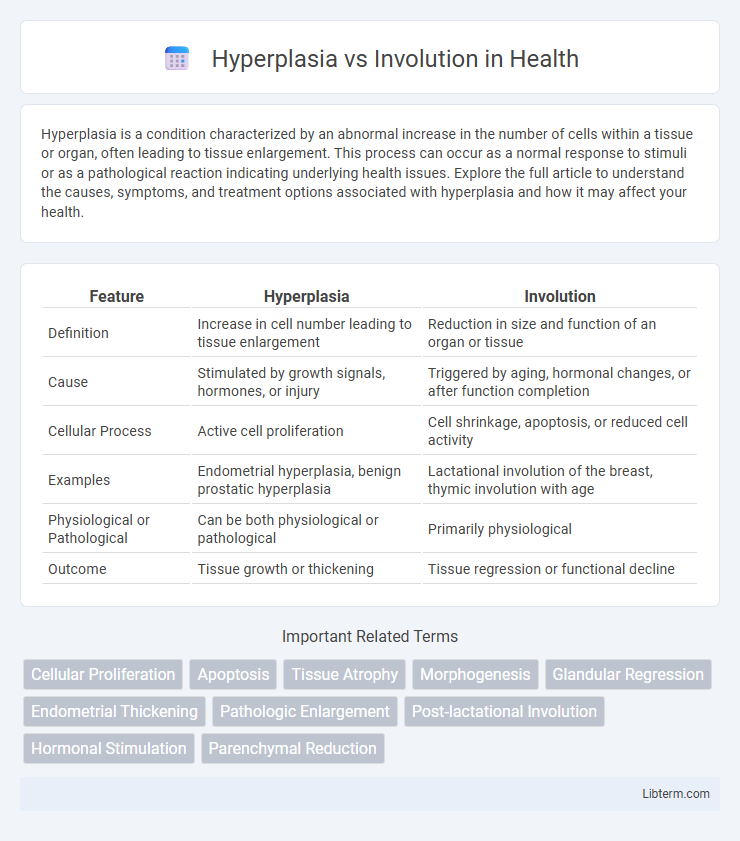Hyperplasia is a condition characterized by an abnormal increase in the number of cells within a tissue or organ, often leading to tissue enlargement. This process can occur as a normal response to stimuli or as a pathological reaction indicating underlying health issues. Explore the full article to understand the causes, symptoms, and treatment options associated with hyperplasia and how it may affect your health.
Table of Comparison
| Feature | Hyperplasia | Involution |
|---|---|---|
| Definition | Increase in cell number leading to tissue enlargement | Reduction in size and function of an organ or tissue |
| Cause | Stimulated by growth signals, hormones, or injury | Triggered by aging, hormonal changes, or after function completion |
| Cellular Process | Active cell proliferation | Cell shrinkage, apoptosis, or reduced cell activity |
| Examples | Endometrial hyperplasia, benign prostatic hyperplasia | Lactational involution of the breast, thymic involution with age |
| Physiological or Pathological | Can be both physiological or pathological | Primarily physiological |
| Outcome | Tissue growth or thickening | Tissue regression or functional decline |
Introduction to Hyperplasia and Involution
Hyperplasia refers to the increase in the number of cells in a tissue or organ, resulting in its enlargement due to enhanced cellular proliferation. Involution is the process of tissue shrinkage or regression, typically involving a reduction in cell size or number as part of normal development or after a physiological stimulus subsides. Both processes are crucial for maintaining tissue homeostasis and adapting to physiological demands.
Defining Hyperplasia: Key Concepts
Hyperplasia is characterized by an increase in the number of cells in a tissue or organ, leading to its enlargement while maintaining normal cell morphology and function. It involves cell proliferation triggered by physiological stimuli, such as hormonal changes or wound healing, distinguishing it from hypertrophy, which is cell size enlargement. Hyperplasia is a controlled, reversible process essential for tissue growth and regeneration, differing fundamentally from involution, which is the reduction or shrinkage of an organ due to cell loss or apoptosis.
Understanding Involution: The Basics
Involution refers to the process where an organ or tissue returns to its normal size after enlargement caused by hyperplasia or hypertrophy, often seen in the uterus post-pregnancy or the thymus after puberty. This process involves cellular apoptosis and tissue remodeling, reducing cell number and restoring baseline function without scarring. Understanding involution is crucial for recognizing how the body maintains homeostasis and recovers from physiological or pathological growth changes.
Causes and Triggers of Hyperplasia
Hyperplasia is primarily triggered by physiological stimuli such as hormonal changes during puberty or pregnancy, and pathological causes like chronic irritation or increased functional demand on tissues. For example, endometrial hyperplasia results from excess estrogen stimulation without progesterone balance, while benign prostatic hyperplasia arises due to hormonal imbalance and aging factors. Unlike involution, which involves tissue regression and cell loss after function diminishes, hyperplasia involves increased cell proliferation driven by specific growth signals and mitogenic factors.
Physiological and Pathological Involution
Physiological involution is a normal, programmed reduction of tissue size, such as the shrinkage of the thymus after puberty and uterine involution postpartum, driven by apoptosis and decreased cellular proliferation. Pathological involution occurs due to disease or injury, often characterized by excessive tissue loss, impaired regeneration, and fibrosis, as seen in chronic liver disease or atrophic gastritis. Hyperplasia contrasts by involving increased cell number due to stimuli like hormonal signals or injury, which can be physiological, such as endometrial hyperplasia during the menstrual cycle, or pathological, like benign prostatic hyperplasia.
Cellular Mechanisms: Hyperplasia vs Involution
Hyperplasia involves an increase in cell number through controlled cellular proliferation regulated by growth factors and mitotic signals, leading to tissue enlargement. Involution is characterized by programmed cell death (apoptosis) and autophagy mechanisms that reduce cellular mass and restore tissue to its baseline state. These opposing cellular processes maintain tissue homeostasis during growth and regression phases.
Clinical Examples in Human Health
Hyperplasia involves an increase in the number of cells, commonly seen in benign prostatic hyperplasia where glandular cells proliferate, leading to urinary obstruction in older men. Involution refers to the reduction or regression of an organ or tissue, exemplified by the postpartum shrinking of the uterus as it returns to its pre-pregnancy size. Both processes highlight dynamic cellular changes with distinct clinical implications in human health.
Diagnostic Approaches for Both Conditions
Diagnostic approaches for hyperplasia primarily involve histopathological examination to identify increased cell proliferation in tissues such as the endometrium or prostate. Involution diagnosis relies on imaging techniques like ultrasound or MRI to assess tissue regression and morphological changes, often observed in mammary gland or thymic tissue. Immunohistochemical markers can further differentiate hyperplasia by indicating cellular activity, whereas involution is characterized by reduced cellularity and increased apoptosis markers.
Therapeutic Implications and Management
Hyperplasia involves an increase in cell number often responsive to hormonal or growth factor stimuli, requiring therapies that target these pathways to control excessive tissue growth. Involution is a physiological regression process marked by apoptosis and tissue remodeling, where management focuses on supporting natural regression and preventing pathological persistence. Understanding the molecular mechanisms driving hyperplasia and involution guides the development of targeted treatments, such as hormone modulators or inhibitors of specific signaling cascades, optimizing patient outcomes in diseases like benign prostatic hyperplasia or postpartum breast involution.
Comparative Summary: Hyperplasia vs Involution
Hyperplasia involves an increase in the number of cells within a tissue, leading to organ enlargement, while involution refers to the reduction in tissue size due to cellular loss or apoptosis. Hyperplasia is typically a response to stimuli such as hormonal signals or growth factors, promoting tissue growth, whereas involution is often seen during aging or post-lactation, facilitating tissue regression and restoration of baseline function. The key difference lies in cell proliferation driving hyperplasia versus programmed cell death driving involution, each regulating tissue homeostasis under different physiological conditions.
Hyperplasia Infographic

 libterm.com
libterm.com